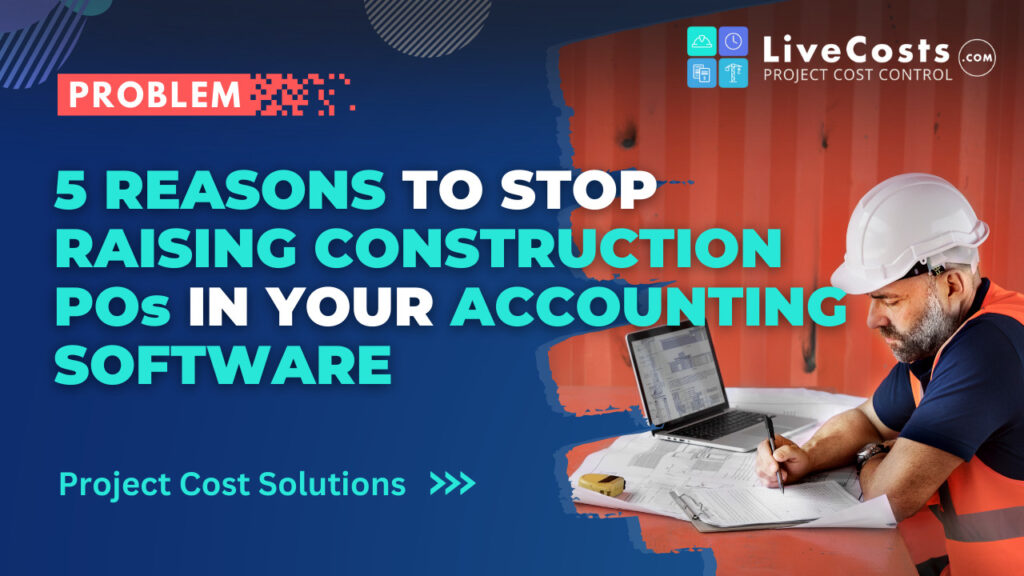PROJECT COST SOLUTIONS
TRANSCRIPTION
I’m going to give you five reasons to stop raising construction purchase orders in your accounting software.
1. The POs are not linked to project phase and cost code. Yes, you will find accounting softwares that can track projects, but most of the time, it’s going to be limited in terms of its reporting, which means that when we raise purchase orders, we can’t drill down into project level, phase level, or even drop down at the cost code level and make sure that all these purchase orders are being deployed to the correct cost code as they’re leaving the company.
2. It does is, it doesn’t allow us to then take in multiple, goods received notices, delivery dockets, delivery tickets against these purchase order as they’re being delivered to site from a material context. So, by doing that external accounting software, setting up an app on site, we can then get full data around these purchase orders and understanding of who’s raising them in our company, what project they belong to, the status in terms of its delivery status, has it been fully delivered, part delivered, tracking the original items on the purchase order versus what’s been delivered against the purchase order, how many invoices have come in against the purchase order. So, ability to take multiple deliveries in, also take multiple invoices in, which is the reality that happens on a day-to-day basis in a construction company.
But in the accounting software, because they’re built for butcher, baker, and candlestick maker, we’re not getting that granular level of detail that we need from a construction purchase order versus a generic purchase order being raised in the accounts.
3. The POs are too rigid. So, we can’t take in multiple invoices, right? I touched on that just here. So, in a case where we want to advance this, let’s say we want to go out and raise a purchase order, not just to multiple phases, multiple cost codes on a project, which the accounting software will struggle to do. But what if I want to go to multiple projects? Again, it’s going to be too rigid to allow us to do that.
So, in a purposely-built construction PO system, we’re going to be able to raise POs. Do they go to one project, three projects, six phases on different projects? All that flexibility is there because that’s what we need when we’re raising construction purchase orders. Then we can take in all the different goods received notices, all the invoices, split invoices, all the day-to-day reality of reconciling invoices to purchase orders can be dealt with because it’s a construction projects tool.
4. Permissions. So, in our accounting software, we might be in a position where we have multiple people that are raising costs against a project. But, if we set up the PO in the accounting software, there’s going to be people in the company, let’s say a project manager, a QS, who are not necessarily the same roles you might want to have giving access to your accounting software. So, you’ve got people in your company that have financial responsibility to the project who are raising costs on the project, who are not necessarily the same people or the same roles that you want to have in around your accounts product. You’ve just created a disconnection between where the cost is happening and where the POs are being raised from. What we need to do is set them up external to the account’s software. So, we’re not sharing sensitive company information and set a permission set to raise POs to what makes sense for that particular role. So, we don’t have the flexibility and permissions in the accounting software to give us the ability to be able to do that.
5. Reports. If we’re raising POs and reports and reconciling those invoices and reports, we’re doing so more following accounts best practices, which is okay, but we’re going to be able to sync that data across anyway. But what we’re missing out on is the data that’s coming in on the invoices. That’s really important to a construction company.
For example, if an invoice comes in related to a purchase order, we’re going to reconcile the line items together, collect those line items into what we call a pricing catalogue. So, that’s a collection of the data. But not only a collection of the data, then being able to run line-item reports against these as well from a material aspect. So, if I search for a product code, I want to see how much I spent on that product code from all the different projects I worked on or from a different supplier, whatever the case might be. It’s an additional layer of data that, again, the accounting software is just not interested in.
So, there’s 5 reasons why you need to stop raising construction purchase orders in your accounting software. If you’d like to see how we can transform your purchasing process, please visit LiveCosts.com. Please feel free to take a free trial or product tour.



